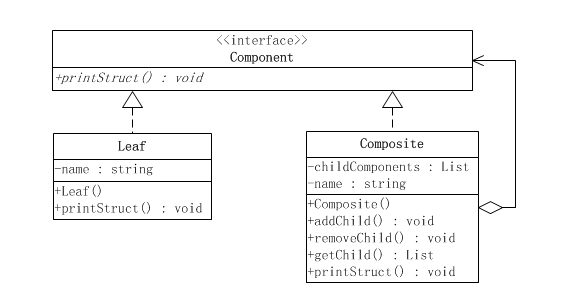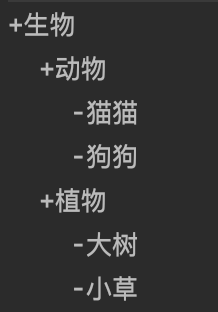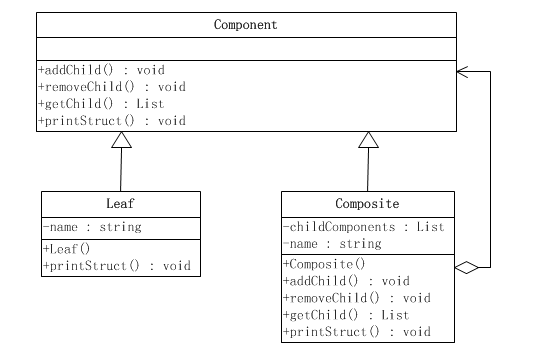目录什么是合成模式安全式合成模式抽象构件(Component)角色树叶构件(Leaf)角色树枝构件(Composite)角色使用透明式合成模式抽象构件(Component)角色树叶构件(Leaf)角色树枝构件(Composite)角色使用安
以下是互联网的解释。
合成模式属于对象的结构模式,有时又叫做“部分——整体”模式。合成模式将对象组织到树结构中,可以用来描述整体与部分的关系。合成模式可以使客户端将单纯元素与复合元素同等看待。
经常会出现有树结构的情况 , 其中由单独的对象或者单独对象组成的合成对象组成 , 此时就需要利用一种方式来完成树结构的构建工作 .
合成模式提供一个树结构中所有对象的统一接口 , 规范树中单独对象和合成对象的构建过程 , 合成模式更像一个数据结构 .
合成模式的实现方式分为透明式和安全式 , 主要区别在于管理方法是在抽象构件中声明, 还是直接在树枝构件中定义.
- 透明式 , 管理方法在抽象构件中声明 , 同时树叶节点需要用平庸的方式实现管理方法
- 安全式 , 在树枝构件中直接定义管理方法 , 这样避免在树叶构件中进行定义 .
设计模式和编程语言无关,但是二当家的依然用Java语言去实战举例。

抽象构件声明了叶子和树枝都应该有的行为。
package com.secondGod.composite;
public interface Component {
void printStruct(String preStr);
}
树叶不会再有下级。
package com.secondgod.composite;
import java.text.MessageFORMat;
public class Leaf implements Component {
private String name;
public Leaf(String name) {
this.name = name;
}
@Override
public void printStruct(String preStr) {
System.out.println(MessageFormat.format("{0}-{1}", preStr, name));
}
}
树枝可以继续长出树枝或者树叶,所以要有addChild方法。
package com.secondgod.composite;
import java.text.MessageFormat;
import java.util.ArrayList;
import java.util.List;
public class Composite implements Component {
private List<Component> childComponents = new ArrayList<Component>();
private String name;
public Composite(String name){
this.name = name;
}
public void addChild(Component child){
childComponents.add(child);
}
@Override
public void printStruct(String preStr) {
// 先把自己输出
System.out.println(MessageFormat.format("{0}+{1}", preStr, name));
// 如果还包含有子组件,那么就输出这些子组件对象
if (this.childComponents != null) {
// 添加两个空格,表示向后缩进两个空格
preStr += " ";
// 输出当前对象的子对象
for (Component c : childComponents) {
// 递归输出每个子对象
c.printStruct(preStr);
}
}
}
}
package com.secondgod.composite;
public class Client {
public static void main(String[]args){
Composite root = new Composite("生物");
Composite c1 = new Composite("动物");
Composite c2 = new Composite("植物");
Leaf leaf1 = new Leaf("猫猫");
Leaf leaf2 = new Leaf("狗狗");
Leaf leaf3 = new Leaf("大树");
Leaf leaf4 = new Leaf("小草");
root.addChild(c1);
root.addChild(c2);
c1.addChild(leaf1);
c1.addChild(leaf2);
c2.addChild(leaf3);
c2.addChild(leaf4);
root.printStruct("");
}
}

执行结果符合预期。

生长树枝和树叶的方法直接声明在抽象构件里。本例使用抽象类,其实也可以使用接口。
package com.secondgod.composite;
public abstract class Component {
public abstract void printStruct(String preStr);
public void addChild(Component child){
throw new UnsupportedOperationException("对象不支持此功能");
}
}
透明式的叶子从实现抽象构件改成继承抽象构件。如果抽象构件是接口,则需要平庸实现管理子构件的方法。
package com.secondgod.composite;
import java.text.MessageFormat;
public class Leaf extends Component {
private String name;
public Leaf(String name) {
this.name = name;
}
@Override
public void printStruct(String preStr) {
System.out.println(MessageFormat.format("{0}-{1}", preStr, name));
}
}
透明式的树枝也是从实现抽象构件改为继承抽象构件,这主要跟抽象构件是抽象类还是接口有关。
package com.secondgod.composite;
import java.text.MessageFormat;
import java.util.ArrayList;
import java.util.List;
public class Composite extends Component {
private List<Component> childComponents = new ArrayList<Component>();
private String name;
public Composite(String name){
this.name = name;
}
public void addChild(Component child){
childComponents.add(child);
}
@Override
public void printStruct(String preStr) {
// 先把自己输出
System.out.println(MessageFormat.format("{0}+{1}", preStr, name));
// 如果还包含有子组件,那么就输出这些子组件对象
if (this.childComponents != null) {
// 添加两个空格,表示向后缩进两个空格
preStr += " ";
// 输出当前对象的子对象
for (Component c : childComponents) {
// 递归输出每个子对象
c.printStruct(preStr);
}
}
}
}
客户端在使用时,变量可以都声明为抽象构件。
package com.secondgod.composite;
public class Client {
public static void main(String[]args){
Component root = new Composite("生物");
Component c1 = new Composite("动物");
Component c2 = new Composite("植物");
Component leaf1 = new Leaf("猫猫");
Component leaf2 = new Leaf("狗狗");
Component leaf3 = new Leaf("大树");
Component leaf4 = new Leaf("小草");
root.addChild(c1);
root.addChild(c2);
c1.addChild(leaf1);
c1.addChild(leaf2);
c2.addChild(leaf3);
c2.addChild(leaf4);
root.printStruct("");
}
}
可以看出,客户端无需再区分操作的是树枝对象(Composite)还是树叶对象(Leaf)了;对于客户端而言,操作的都是Component对象。
安全式:从客户端使用合成模式上看是否更安全,如果是安全的,那么就不会有发生误操作的可能,能访问的方法都是被支持的。
透明式:从客户端使用合成模式上,是否需要区分到底是“树枝对象”还是“树叶对象”。如果是透明的,那就不用区分,对于客户而言,都是Compoent对象,具体的类型对于客户端而言是透明的,是无须关心的。因为无论树叶还是树枝,均符合一个固定的接口。
到底使用安全式还是透明式需要看需求,大家看着办吧。
以上就是java合成模式之神奇的树结构的详细内容,更多关于java合成模式的资料请关注编程界其它相关文章!
--结束END--
本文标题: java合成模式之神奇的树结构
本文链接: https://lsjlt.com/news/77.html(转载时请注明来源链接)
有问题或投稿请发送至: 邮箱/279061341@qq.com QQ/279061341
2024-02-29
2024-02-29
2024-02-29
2024-02-29
2024-02-29
2024-02-29
2024-02-29
2024-02-29
2024-02-29
2024-02-29
回答
回答
回答
回答
回答
回答
回答
回答
回答
回答
0